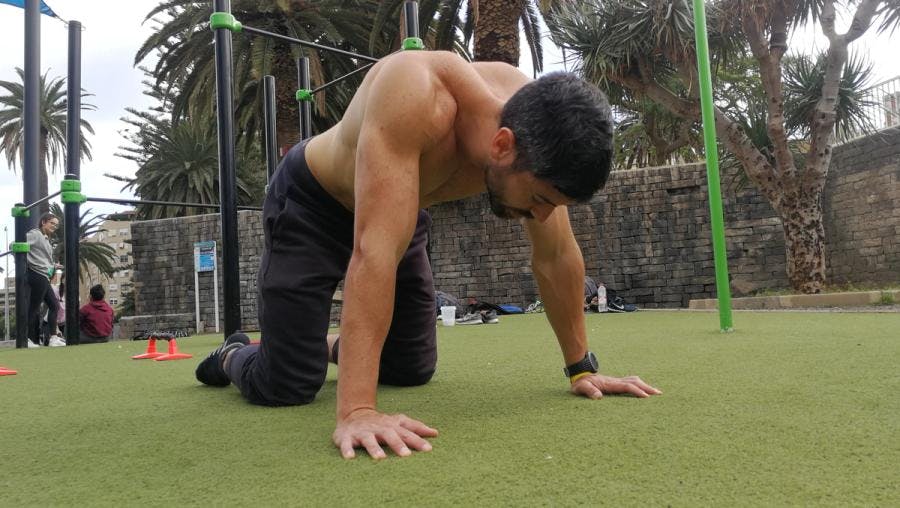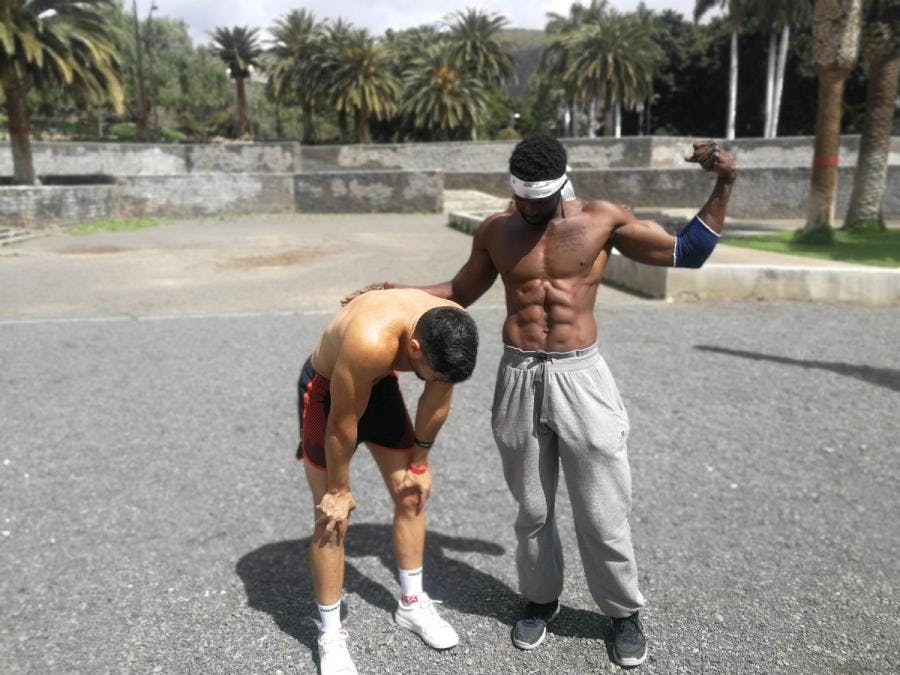
Some times it is difficult to know where is the limit to your training, are you training enough? are you training too much? Nowadays there is a lot of fear to over training, to the point that some times our training is too light.
On the other side, there is people who do train too much and could benefit from having more recovery time and less training volume.
In this article I am going to give you my opinion about how to find the best amount of training volume and intensity so you get the best results.
Overtraining as an excuse to train too little
Our nature as human beings makes us want to put the less effort possible in any endeavor we take. So when we see a video on the internet explaining the risks of overtraining, we tend to use that as an excuse to train less and be more lazy. Lets see some ideas on that problem:
Firstly, training the same muscle several days in a row won't make it burn itself, lose muscle mass nor any other problem. This "bro science myth" derives from the weider training plans, where people train different muscle groups each day.
Those type of training were originally for professional bodybuilders who, searching for hypertrophy, worked for hours each muscle to its limit, with exercises that gave as much isolation to that muscle as possible. That was to the point that the muscle was exhausted and useless for days. So for them there was no reason to train that muscle again the next day.
In Calisthenics, this type of training is almost non-existent. First because our exercises do not isolate individual muscles as the gym machines do, so you cannot give that specific workload to a certain muscle. And secondly because Calisthenics training is not designed to only get muscle hypertrophy, as bodybuilding certainly is.
That's why my recommendation is that you don't worry about training several times the same muscles, and don't let that stop your progression because for calisthenics athletes that is not a problem per se. Of course if you are trying to get muscle mass, it is normal that you center your routine around one or two muscle groups every day, but don't worry if you repeat some specific muscle from one day to the other, and above all, don't let that affect the intensity or the frequency of your routines.
Another point I want to make is that if you feel a little tired, missing some strength or a little unmotivated, doesn't mean anything and it is completely normal. For example in my case if I would only train when I feel at 100%, full of energy and strength, I would only train once every 5 days or so... and would obviously get worse results. If you want optimal results, you should be mentally strong and train with discipline.

Does overtraining really exist?
To really be over trained, and get your performance and results affected, is something really difficult to achieve, and definitely far from the reach of a lot of people who are afraid of it.
In my opinion, to be over trained you need to do something like train 6 or 7 days in a row with a very high intensity, really hard routines, or training more than once a day a lot of days in a row. Or maybe training for 3 or 4 weeks every day withou fort resting... what I want to say is that it has to be something quite extreme in order to reach over training.
If you manage to do it, you will feel really tired, sleepy, unmotivated, weak, bad tempered, continuos muscle and joint pain, stress... It will be pretty obvious.
And there is when you need to do something about it. And it will be as easy as rest for a couple days, and then do some low intensity training for a couple more days, or even do 4 or 5 days of absolute rest. But I want to insist that those are extreme cases of real intense and frequent workouts, don't think that training 2 days in a row will make you over trained.
In my personal experience, I think I have only been overtrained once or twice since I started doing Calisthenics. For example when I did my leg challenge, where I trained leg routines 3 or 4 times a week plus my regular routines. And also some times when preparing to compete where I trained every day with a lot of intensity, knowing that before the competition I would rest for 3 or 4 days.

The best athletes in the world are not afraid of over training
To insist on the point of this article, lets see the example of Daniels Laizans, 3 times world champion in Calisthenics and Street Workout on the freestyle category.
I did an interview with him an interview with him, where he explained his routine: Daniels does on every training some freestyle combos, some holding elements combos, then he practices new tricks and then he trains basic exercises, and he does this for 5 or 6 days a week.
As you can see from that schedule, on every training day he works on the same muscles. Every time he does holding combos, he repeats planche, front lever, working hard on his shoulders, lats etc. And as you can see, it has worked pretty well for him... Lots of the best athletes on the world train in this way, because they do a lot of freestyle and repeat the same tricks, exercises and movements every day.
In my own case, I also train in this way, some days I center my training around planche and pushing, other days around front lever and pulling... but at the start of every training I always practice some combos and holding exercises so on every training I repeat muscle groups and it works quite well, I have had very good results and I am pretty happy with my progress.
Also the vast majority of resistance athletes repeat always the same exercises and at a very high intensity, because the whole point of their training is to do lots of reps of the same basic exercises. These athletes have some of the most impressive physiques of our sport.
As you have probably noticed, my advice is that if you want really good results, don't underestimate your body's potential, don't be over protective because you will fall in the pit of training too little.
Over training and injury risk
This takes us to the next point, which is injury prevention. Obviously one of the risks of training with a lot of intensity and frequency is that you can get injured. This is something completely normal that exists on every sport, and in calisthenics it is really easy to avoid.
If you are trying to do an exercise and you cannot execute it correctly, you are losing the form, you are forcing too much etc. Stop it and do another easier one that works on the same muscle groups and requires the same kind of strength, but do it correctly, avoiding risks. That way you can train hard without fear of injury. For more information on how to avoid injuries we have an article dedicated to that matter on the app.
Also another important point is to take care of your diet and rest periods. If you train hard but you sleep too little and eat unhealthy, it will be easier that you feel over trained. But if you sleep a minimum of 7 hours every day and have a healthy, nutrient rich diet, you will be able to tolerate the intensity of your training without problem. We also have an article about healthy diet on the app if you want more information.
In calisthenics we also have the problem of the calluses in your hands. If your hands hurt because of too much training, it is probable that you can use that as an excuse for not training on an specific day. But that problem is too easy to solve, for example in my case if my hands hurt I cando only statics that day, without dynamic movements. And if they are destroyed I can train only on the floor. Another way to surpass this problem is to train legs that day.
But nothing stops me to do a good routine that keeps me on track. In the app you have an article about how to take care of your hands if you want to check it.
To finish I want to tell you something about scientific studies and their interpretation, which is where most of this over training fear comes from. When you see that some study is referenced, you have to go a little bit beyond that and don't believe it blindly. Check who "sponsored" it, who was studied, which physical capabilities did they have, which exercise or training did they do, and which factors did they analyze. Some times if you just read the title or the conclusions, or even worse, the interpretation of someone who "read" it, you can be mislead.
Autor

Yerai Alonso
Cofundador de Calisteniapp, referente en calistenia y el street workout en Español. Con más de una década de experiencia, es creador de uno de los canales de YouTube más influyentes del sector. Autor del libro La calle es tu gimnasio, campeón de Canarias y jurado en competiciones nacionales e internacionales.
Junte-se ao nosso boletim informativo
NOVOS ARTIGOS TODA SEMANA
Aprenda tudo o que precisa saber sobre calistenia
Calisteniapp
Comece a treinar calistenia e treino de rua
